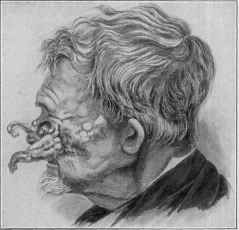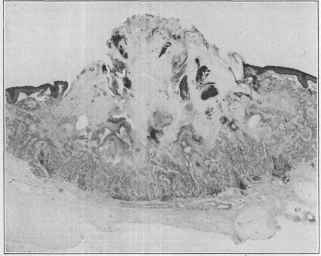| MEDICAL INTRO |
| BOOKS ON OLD MEDICAL TREATMENTS AND REMEDIES |
THE PRACTICAL |
ALCOHOL AND THE HUMAN BODY In fact alcohol was known to be a poison, and considered quite dangerous. Something modern medicine now agrees with. This was known circa 1907. A very impressive scientific book on the subject. |
DISEASES OF THE SKIN is a massive book on skin diseases from 1914. Don't be feint hearted though, it's loaded with photos that I found disturbing. |
CORNU CUTANEUM
Synonyms.—Cornu humanum; Cutaneous horn; Horny excrescence; Horny
tumor; Fr., Corne cutanée; Corne de la peau; Ger., Hauthorn; Hornauswuchs.
Definition.—Cornu cutaneum is a true horny cutaneous out
growth varying in size and shape.
Symptoms.—Horns are rarely met with in human beings, and
may be classed as dermatologic oddities. Although resembling animal
horns closely, their anatomic structure differs in not containing bone
and in having a cutaneous attachment, and therefore more or less mova
ble, whereas the former are located upon an osseous base. They show
a preference for the hairy scalp and for the face, occurring occasionally
elsewhere, as on the trunk, cheeks, eyelids, glans, scrotum, and extremi
ties, no part of the body, however, being exempt. Occurring on the
penis, they not uncommonly develop from acuminated warts, as in the
remarkable cases recorded by Pick1 and by Brinton.2 While generally
solitary, they may be multiple, and may occur in quite large numbers,
as in a case reported by Bätge,3 in which the whole lower part of the body
was studded with these growths, although, with the exception of 2,
all were of small size. Their appearance is usually slow and insidious,
although exceptionally somewhat rapid; in their earliest formation there
is a resemblance to a hard wart, and they may, in fact, begin as a simple
verrucous growth. Their size and shape are also subject to variations;
thus they may be only large pin-head in size, and again they may measure
several or more inches in length; the unusual length of 12 inches has been
recorded. Their diameter varies from 1/8 of an inch to 4 or 5 inches, and
is greater at the base than at the extremity. Rodriguez‘s extraordinary
case, quoted by Crocker, growing on the side of the head, was 14 inches
around at the base. Porcher4 also observed a similar case, on the side of
the scalp, the horn being, however, much smaller.
In appearance they are solid, rough, wrinkled, and laminated and
1 Pick, Archiv, 1875, p. 315 (with two colored plates; also refers to 9 other cases).
2 Brinton, Medical News, Aug. 6, 1887 (with a résumé of 15 other cases); Gould,
London Pathol. Soc'y Trans., 1887, vol. xxxviii, p. 355, also records a case, associated
with epithelioma.
3 Bätge, Deutsche Zeitschrift für Chirurg., 1876, vol. vi, p. 474 (also records another
case having 6 upon the face, with illustrations and references to other cases).
4 Porcher, Charleston Med. Jour, and Rev., 1855, p. 333 (with résumé of other cases
of cutaneous horn and references).
CORNU CUTANEUM
559
round, angular, pointed, straight, or twisted. They show different
shades of color, as gray, yellow, brown, or black. The base is concave
or flattened and is seated directly upon and in the skin; the neighboring
integument may be normal or inflammatory in appearance, and some
times inflammatory action is followed by suppuration, and the horn may
be cast off. As a rule, their growth is slow and they do not give rise to
subjective symptoms unless they are injured by traumatism or torn off,
in which case the base presents an ulcerating surface, which may again
become the seat of a horn. After reaching a variable size they may re
main stationary; or, when having reached a certain length, they may grow
loose and finally drop off, usually preceded, however, by a localized
degenerative process, which is left behind and commonly develops into
epithelioma. According to Lebert, 12 per cent, of the cases have an

Fig. 132.—Cutaneous horns, showing beginning epitheliomatous degeneration of the
base (after Pancoast).
epitheliomatous termination. This development in its early stages is
shown in the accompanying case (Pancoast),1 and another example of this
tendency is shown in Gould‘s patient.
Etiology and Pathology.—We are lacking in positive knowl
edge as to the exciting causes. Although usually occurring after forty
years of age, they have been observed in the very young; they are some
what more frequent in females than in males. The growth is rare,
although quite a number of cases are now on record.2 It is not improb
able that isolated instances of limited ichthyosis hystrix and keratosis
follicularis may have been included. They may have their starting-
1 Pancoast, Photog. Review of Med. and Surg., 1870-71, vol. i, p. 3.
2 Wilson, Med.-Chir. Trans., 1844, vol. xxvii, p. 52, and Dis. of the Skin, sixth
edit., p. 796, gives a summary of 90 cases and references; Bergh, “Fälle von Haut-
hörnern,” Archiv, 1873, p. 185; Lebert, Ueber Keratose, Breslau, 1864 (a collection of
109 cases); Hessberg, Beitrag zur Kenntniss der Hauthörner von Menschen und Thieren,
Dissertation, Göttingen, 1868, adds 25 to Lebert‘s list; Joseph (Caspary Festschrift),
Archiv. C. 1910, p. 343, adds 2 cases, and reviews the pathologic theories.
560 HYPERTROPHIES
point in cutaneous injuries or lesions, such as sebaceous cysts, scars,
warts, and other keratoses.
Horns, in their earliest stage at least, bear a close resemblance histo-
logically, as well as clinically, to warts. They arise usually from the deeper
layers of the stratum mucosum, either from that lying above the papillæ
or from that lining the follicles and glands; and are to be attributed to
a pathologic hypertrophic and cornified condition of the epidermic
cells, the earliest stage of their formation consisting, according to Unna,
in a simultaneous acanthosis and hyperkeratosis. The papillæ are
hypertrophied, and the growth is situated on the papillæ, and not in
frequently groups of greatly enlarged papillæ extending some distance
into the horny mass have been observed. The base is surrounded by
telangiectatic blood-vessels, which sometimes ramify into the horn sub
stance. The horny formation itself consists essentially of agglutinated

Fig. 133.—Small beginning cutaneous horn, X about 20; showing broadened base
extending down into the corium and the projecting rounded summit (courtesy of Dr.
B. H. Buxton).
epidermic cells, forming small columns or rods; in the columns themselves
the cells are arranged concentrically.
Treatment.—The growth, as a rule, does not show a tendency
to recur if thoroughly removed. It must not be overlooked that, if
neglected, epithelioma may develop. Quite frequently it is accidentally
knocked off, but under such circumstances, unless the base is cauterized,
it is apt to regrow.
The radical treatment of these growths, therefore, consists in their
detachment, and subsequently the destruction of the base. The former
is accomplished by dissecting it away from the base or forcibly breaking
it off; the latter by means of any of the well-known caustics, such as
caustic potash, chlorid of zinc, and the galvanocautery. A rapid method
is to excise the base, the horn coming away with it; this necessitates,
however, considerable loss of tissue.
But first, if you want to come back to this web site again, just add it to your bookmarks or favorites now! Then you'll find it easy!
Also, please consider sharing our helpful website with your online friends.
BELOW ARE OUR OTHER HEALTH WEB SITES: |
Copyright © 2000-present Donald Urquhart. All Rights Reserved. All universal rights reserved. Designated trademarks and brands are the property of their respective owners. Use of this Web site constitutes acceptance of our legal disclaimer. | Contact Us | Privacy Policy | About Us |